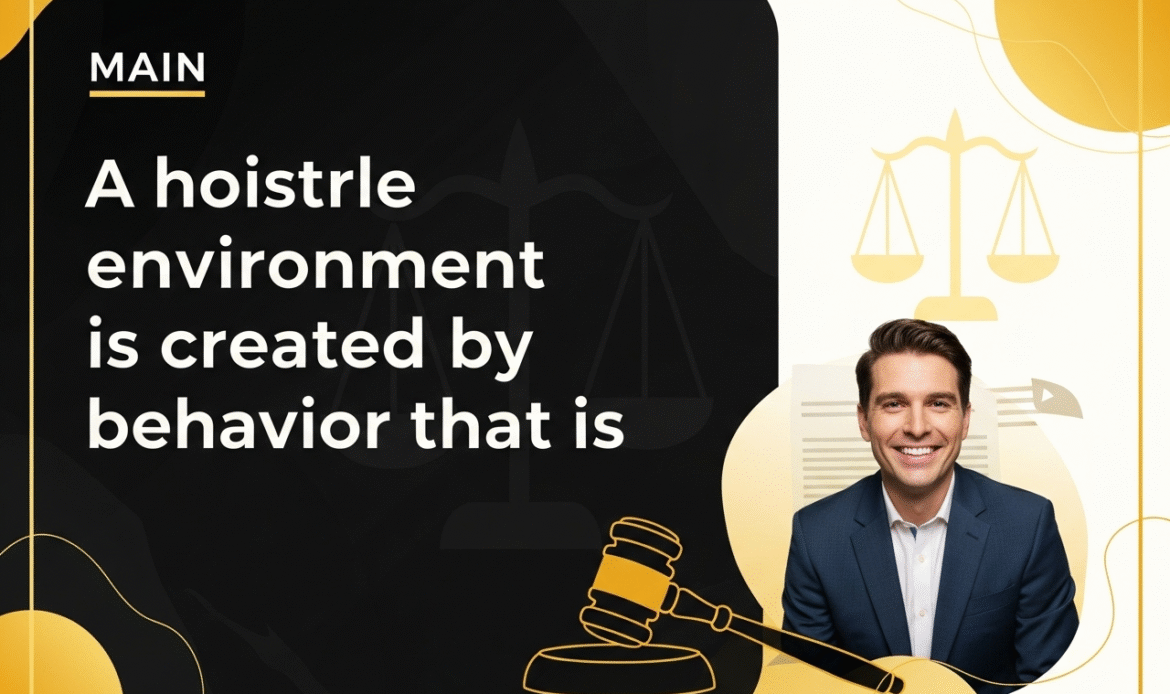Work should feel safe and respectful. Yet many employees face conditions that make them anxious, intimidated, or unwelcome. A hostile environment does not happen by accident. It develops through behaviors, actions, and patterns that interfere with an employee’s ability to work.
In this article, you will learn what a hostile environment means, the behaviors that create it, legal standards that define it, and how organizations can prevent and respond effectively.
What Is a Hostile Work Environment?
A hostile work environment occurs when repeated actions, comments, or conduct create an atmosphere of fear, harassment, or intimidation. It goes beyond simple disagreements or occasional rudeness.
Courts and workplace regulators define it by behavior that affects employment, interferes with job performance, or creates a climate that any reasonable person would find abusive.
The U.S. Equal Employment Opportunity Commission (EEOC) links hostile environments to discrimination based on race, gender, religion, disability, age, or other protected categories.
Behaviors That Create a Hostile Environment
- Severe or Pervasive Harassment
When harassment is ongoing or extremely serious, it shifts the workplace atmosphere. Jokes, comments, or physical actions that target someone’s identity can rise to this level.
- Discrimination Based on Protected Traits
Behavior that singles out or demeans workers due to race, gender, age, sexual orientation, religion, disability, or national origin often creates hostility.
- Unwelcome Conduct
If an employee communicates that behavior is offensive, and it continues, that conduct is legally unwelcome. Unwanted sexual advances, repeated insults, or offensive images fall here.
- Intimidation and Threats
Work environments turn hostile when managers or coworkers use threats, bullying, or intimidation to silence or control others.
- Retaliation for Complaints
Employees who report issues must not be punished. Retaliation—whether through demotions, exclusion, or criticism—creates hostility and violates federal law.
Legal Factors That Define Hostility
Courts weigh four main factors when deciding if an environment is hostile:
- Frequency of behavior: Was it isolated or ongoing?
- Severity: Was it offensive comments or threats of harm?
- Impact on work: Did it make job performance harder?
- Perspective of reasonableness: Would a reasonable person find it abusive?
An environment must usually meet more than one of these elements to qualify legally.
Examples of Hostile Behavior
- Sexual jokes or repeated comments about appearance
- Displaying offensive images, posters, or symbols
- Using racial slurs or derogatory nicknames
- Spreading harmful rumors about personal life
- Sabotaging work assignments intentionally
- Consistently yelling, mocking, or belittling employees
These actions, when persistent, create a culture of fear and humiliation.
The Cost of a Hostile Environment
The impact goes beyond discomfort. According to workplace studies in 2024, companies with toxic cultures face higher turnover, lower productivity, and legal risks. Employees in hostile environments experience stress-related health issues, reduced engagement, and burnout.
For organizations, lawsuits can lead to millions in settlements. The EEOC recovered over $440 million in workplace harassment and discrimination claims in 2023 alone.
Preventing Hostile Environments
Build Clear Policies
Workplaces need clear, written policies against harassment and discrimination. Policies must explain examples of misconduct, how to report issues, and consequences for violations.
Train Employees and Managers
Mandatory training helps employees recognize hostile behaviors. Supervisors must learn how to respond quickly and consistently.
Encourage Open Reporting
Anonymous hotlines and HR reporting systems allow employees to raise concerns without fear.
Enforce Accountability
Policies only work when enforced. Organizations must act promptly, investigate fairly, and discipline offenders.
Employee Rights and Protections
Employees facing hostile environments have legal rights. They can:
- Report the issue to HR or a manager
- File a complaint with the EEOC
- Seek legal action if retaliation or harassment continues
Federal law, including Title VII of the Civil Rights Act, protects employees from discrimination and harassment tied to protected traits.
How to Respond as an Employee
If you believe you are in a hostile work environment:
- Document every incident with dates and details.
- Save evidence such as emails, messages, or images.
- Report concerns internally through HR or supervisors.
- Seek outside legal or regulatory help if internal steps fail.
Hostile Environment vs. Difficult Boss
Not every bad workplace qualifies as hostile. A demanding manager, strict deadlines, or occasional arguments do not create a hostile environment unless linked to discrimination or harassment.
The key difference is whether the behavior targets protected traits or becomes severe enough to harm work performance.
Recent Trends in Workplace Hostility
Modern workplaces face new challenges. Remote work has expanded harassment into digital spaces. Offensive messages, video call misconduct, and cyberbullying contribute to hostile environments.
Data also shows younger workers are more likely to report toxic culture than older generations. Organizations must adapt policies to cover both physical and virtual environments.
Case Studies of Hostile Environments
Real cases show how hostile environments develop. In one EEOC lawsuit, a tech company paid millions after women reported constant sexual jokes and ignored complaints. In another, warehouse workers faced racial slurs and graffiti for months before management acted. Both highlight the cost of neglect.
Courts often rule that inaction by management strengthens the case. When leadership fails to investigate or stop harassment, liability grows. These examples stress why companies must respond quickly.
Hostility in Remote Work
Remote settings are not immune. Harassment now happens in video calls, group chats, and emails. Offensive memes, inappropriate backgrounds, or exclusion from online meetings can create hostile digital spaces.
A 2023 survey found 38% of remote workers reported disrespectful online communication. Many said it felt harder to report because incidents left fewer witnesses. Companies must treat online behavior with the same seriousness as in-office conduct.
Industry-Specific Risks
Some industries see more hostile environments due to culture or power dynamics.
- Hospitality: Workers face harassment from customers and supervisors. Long shifts increase vulnerability.
- Healthcare: Nurses and staff report bullying from senior doctors and patients.
- Construction: Harsh language and discriminatory jokes remain common.
- Tech: Women and minorities face subtle exclusion and hostile “bro culture.”
Recognizing industry patterns helps organizations target training and policy enforcement.
Psychological Impact on Employees
Employees in hostile workplaces face long-term health issues. Anxiety, depression, and loss of self-confidence are common. Stress hormones increase, leading to physical problems like insomnia, headaches, or high blood pressure.
Studies show employees in toxic workplaces are twice as likely to quit within a year. Many leave their careers altogether, feeling burned out beyond repair.
The Role of Leadership
Leadership sets the tone. When leaders ignore misconduct, hostility thrives. When they model respect, culture shifts.
Executives must communicate zero tolerance and support those who report issues. Managers should not only enforce rules but actively build respect through recognition and fairness.
Accountability at the top ensures the whole organization follows. Without it, policies become empty words.
Hostile Environment and Retaliation
Retaliation is one of the most reported forms of workplace hostility. After employees speak up, some face demotion, isolation, or subtle punishment.
Retaliation is illegal under federal law, but it remains widespread. According to EEOC data, over half of all complaints in 2023 involved retaliation. This shows how vulnerable workers feel after reporting.
Protecting whistleblowers is essential for trust. If workers believe reporting will cost them their job, hostile behavior goes unchecked.
Cultural Differences and Hostility
What feels hostile in one culture may be seen differently in another. Still, global workplaces must adopt universal respect.
For example, humor acceptable in one region may be offensive in another. Language barriers can also create exclusion. Multinational companies must train staff to recognize these differences and avoid unintentional hostility.
Respect across cultural lines prevents misunderstandings from escalating into legal or ethical problems.
Hostility and Power Imbalances
Hostile environments often grow where power is concentrated. Supervisors who control schedules, promotions, or paychecks may use their influence to pressure employees.
This can lead to subtle coercion: withholding projects, giving poor reviews, or excluding workers from opportunities. Such acts, while less visible than insults, still poison workplace culture.
Addressing power abuse requires oversight and clear grievance systems that bypass direct supervisors.
Role of Bystanders
Coworkers who witness harassment play a critical role. Silence enables hostility. Speaking up, supporting victims, or reporting can stop harm early.
Bystander intervention training teaches staff how to safely act. Even small actions, like redirecting a conversation or checking in privately, reduce isolation for targets.
Organizations that empower bystanders create stronger cultures of accountability.
Financial Costs for Employers
Beyond lawsuits, hostile environments drain businesses financially. High turnover forces costly recruitment. Productivity drops as employees disengage.
Reputation damage discourages talent and customers. A survey in 2024 showed 58% of job seekers avoided companies with reported toxic cultures.
For small businesses, even one public case can cripple growth. Prevention is not only ethical but also financially wise.
Technology for Prevention
Modern HR tech helps detect patterns of hostility. AI-driven tools scan emails or chat platforms for offensive language. Anonymous reporting apps allow safe submissions.
However, tech must support—not replace—human judgment. Companies need both tools and empathetic leaders to resolve conflicts.
Global Legal Perspectives
Different countries define hostile environments differently.
- U.S.: Laws focus on discrimination tied to protected traits.
- UK: Equality Act prohibits harassment based on protected characteristics.
- EU: Directives require member states to address workplace harassment.
- Canada: Employers have a “duty to accommodate” and prevent harassment.
Multinational firms must align policies with each jurisdiction. Ignoring local law creates exposure to multiple lawsuits.
The Future of Workplace Safety
Trends point to more proactive approaches. Younger employees demand transparency and accountability. Social media amplifies workplace misconduct, making it impossible for organizations to hide hostile practices.
Future workplaces will focus more on psychological safety. Respect and inclusion will be measured alongside productivity. Forward-thinking companies will adopt mental health programs, regular climate surveys, and open dialogue forums.
Conclusion
A hostile environment is not about minor conflict. It arises when behaviors are severe, unwelcome, or discriminatory, creating fear and damaging job performance.
Preventing it requires clear policies, strong leadership, and open communication. Employees have legal rights, and companies face real risks if they ignore the problem.
Understanding the behaviors that create hostility allows both workers and employers to act before harm escalates.
Robert Stewart is a seasoned law blog writer with a passion for translating complex legal concepts into accessible, informative content. With a keen eye for detail and a knack for storytelling, Robert crafts engaging articles that educate and empower readers in the realm of law.
Drawing upon his extensive experience in the legal field, Robert brings a wealth of knowledge to his writing, covering a diverse range of topics including personal injury, family law, criminal defense, and more. His articles combine thorough research with clear, concise language, making them valuable resources for both legal professionals and laypeople alike.


